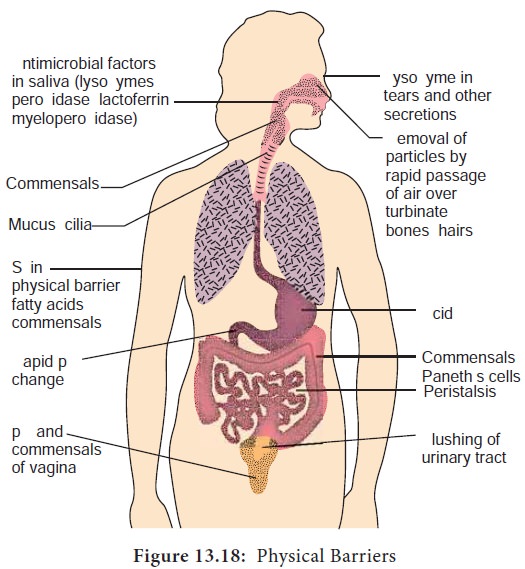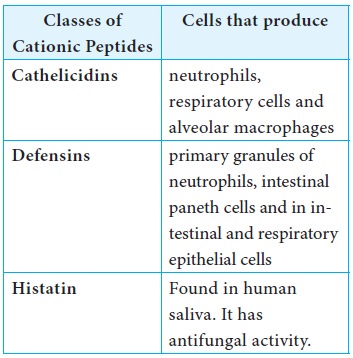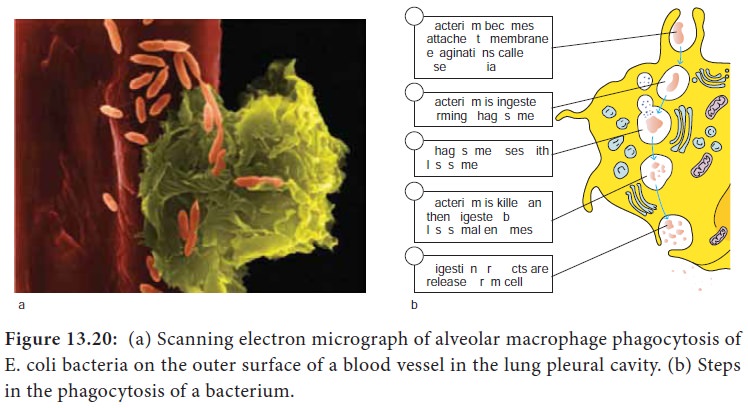Chapter: 11th Microbiology : Chapter 13 : Immunology
Mechanisms of Innate Immunity
Mechanisms of Innate Immunity
A potential microbial pathogen invading a human host immediately confronts a vast array of nonspecific defence mechanisms. Many direct factors (nutrition, physiology, fever, age, genetics) and equally as many indirect factors (personal hygiene, socioeconomic status, living conditions) influence all host microbe relationships. In addition to these direct and indirect factors, a vertebrate host has the following four non specific defence mechanisms.
A. Physical barriers
B. Chemical mediators
C. Phagocytosis
D. Inflammation
A. Physical barriers
i) Skin
Intact skin contributes greatly to host resistance. It forms a very effective mechanical barrier to microbial invasion. Its outer layer consists of thick, closely packed cells called keratinocytes, The skin is slightly acidic (around pH 5-6) due to skin oil, secretion from sweat glands and organic acids produced by commensal Staphylococci. It also contains a high concentration of sodium chloride and is subject to periodic drying.
ii) Mucous membranes
The mucous membranes of the eye (conjunctiva), the respiratory, digestive and urogenital systems withstand microbial invasion. The intact stratified squamous epithelium and mucus secretions form a protective covering that resists penetration and traps many microorganisms. Many mucosal surfaces are bathed in specific antimicrobial secretions. One antibacterial substance in these secretions is lysozyme, an enzyme that lyses bacteria. Mucous secretions possess the iron binding protein, lactoferrin. Lactoferrin sequesters iron from the plasma reducing the amount of iron available to invading microbial pathogens and prevents their ability to multiply. Mucous membranes produce lactoperoxidase, an enzyme that catalyzes the production of superoxide radicals, reactive oxygen intermediate that is toxic to many microorganisms.
iii) Respiratory system
The mammalian respiratory system has strong defense mechanisms. The average person inhales at least eight microorganisms a minute or 10,000 each. Microbes larger than 10μm are trapped by hairs and cilia lining the nasal cavity. The cilia in the nasal cavity beat toward the pharynx, so that mucus with its trapped microorganisms is moved toward the mouth and expelled. Microbes smaller than 10μm pass through the nasal cavity and are trapped by the mucociliary blanket and the trapped microbes are transported by ciliary action that moves them away from lungs. Coughing and sneezing reflexes clear the respiratory system of microorganisms by expelling air forcefully from the lungs through the mouth and nose, respectively. Salivation also washes microorganisms from the mouth and nasopharyngeal areas into the stomach.
iv) Gastrointestinal tract
Most microorganisms that reach the stomach are killed by gastric juice. (pH 2-3). However, organisms embedded in food particles are protected from gastric juice and reach the small intestine. There microorganisms are damaged by various pancreatic enzymes, bile, enzymes in intestinal secretions and GALT system. Normal microbiota of the large intestine is important in preventing the establishment of pathogens. The mucous membranes of the intestinal tract contain paneth cells. These cells produce lysozyme and cryptins (toxic for bacteria).
v) Genitourinary tract
Under normal circumstances, the kidneys, ureters and urinary bladder of mammals are sterile. Urine within the urinary bladder is also sterile. In addition to removing microbes by flushing action, urine kills some bacteria due to its low pH and the presence of urea and other metabolic end products (uric acid, hippuric acid, indican, fatty acids, mucin, and enzymes). The acidic environment (pH 3-5) of the vagina is unfavorable to most microbes.
vi) Eye
The conjunctiva is specialized mucus secreting epithelial membrane that lines the interior surface of each eyelid and the exposed surface of the eye ball. It is kept moist by the continuous flushing action of tears. Tears contain large amounts of lysozyme, lactoferrin, and antibody and thus provide chemical as well as physical protection (Figure 13.18).

B. Chemical mediators
Antimicrobial peptides
They are low molecular weight proteins that exhibit broad spectrum antimicrobial activity toward bacteria.
i) Cationic peptides
Cationic peptides are found in humans. There are three generic classes of cationic peptides that have the ability to damage bacterial plasma membrane.

ii) Bacteriocins
Bacteriocins are produced by gram negative and gram positive bacteria. For example, Escherichia coli synthesize bacteriocins called colicins. Colicins causes cell lysis.
Cytokines
Cytokines are proteins made by cells that affect the behavior of other cells. When released from mononuclear phagocytes, they are called monokines. When released from T lymphocytes they are called lymphokines. When released from leukocytes they are called interleukins. Cytokines are required for regulation of both the nonspecific and specific immune responses. Interferons (IFNS) are a group of cytokines produced by virus infected cells. Several classes of interferons are recognized. IFN γ is synthesized by virus infected leukocytes, antigen stimulated T cells and natural killer cells. IFN α / β is derived from virus infected fibroblasts. Interferons prevent viral replication and assembly, thereby limiting viral infection.
Another group of noteworthy cytokines are endogenous pyrogens which elicit fever in the host. Examples of endogenous pyrogens include interleukin – 1, Interleukin – 6 and tissue necrosis factor. All are produced by host macrophages in response to pathogens.
Complement system
The complement system is a part of the immune system, consists of a series of proteins that interact with one another in a highly regulated manner, in order to eliminate pathogens. Complements are soluble proteins and glycoproteins mostly produced by hepatocytes. More than 20 types of complements are present in serum found circulating normally in human body in inactive forms (called as zymogens or proenzymes). Complement activation is triggered by an antibody when it is bound to the antigen. It can also be triggered by some components of innate immunity. Thus the complement system works in both innate and acquired immunity.
Complement activation and cell lysis
The complement activation occurs via three pathways which are:
1. Classical pathway
2. Alternative pathway
3. Lectin pathway (or mannose binding lectin pathway)
Classical pathway, activated by antigen-antibody reaction, Alternative pathway, activated on microbial cell surfaces, and Mannose binding Lectin pathway, activated by a plasma lectin that binds to mannose residues on microbes (Figure 13.19).

Functions of complements
Some major functions of complements are:
· Opsonization and phagocytosis
· Cell lysis
· Chemotaxis
· Activation of mast cells and basophils and enhancement of inflammation
· Production of antibodies
· Immune clearance and inflamma-tion by attracting macrophages and neutrophils.
C. Phagocytosis
i. Phagocytosis is the ingestion by phagocytic cells of invading foreign particles such as bacteria. After ingestion, the foreign particle is entrapped in a phagocytic vacuole (phagosome), which fuses with lysosomes forming the phagolysosome. The lysosomes release their powerful lytic enzymes which digest the particle. (Figure 13.20). Phagocytosis is conducted by blood monocytes, neutrophils and tissue macrophages. Phagocytosis may be enhanced by a variety of factors collectively referred to as opsonins which consist of antibodies and various serum components of complement.
ii. Phagocytic cells use two basic mechanisms for the recognition of microorganisms. Opsonin dependent and opsonin independent
iii. Phagocytesuse pathogen recognition receptors to detect pathogen associated molecular patterns on microorganisms. Toll like receptors are a distinct class of pathogen recognition receptors.

D. Inflammation
Tissue damage caused by a wound or by an invading pathogenic microorganism induces a complex sequence of events collectively known as inflammatory response. Inflammation can either be acute or chronic. The gross features were described over 2000 years ago and are still known as the cardinal signs of inflammation: redness (rubor), warmth (calor), pain (dolor), swelling (tumor), and loss of function (functiolaesa)
The cardinal signs of inflammation reflect the three major events of an inflammatory response.
1. Vasodilation (an increase in the diameter of blood vessels) of nearby capillaries occurs as the vessels that carry blood away from the affected area constrict. This results in engorgement of the capillary network. The engorged capillaries are responsible for tissue redness (erythema) and an increase in temperature.
2. An increase in capillary permeability facilitates an influx of fluid and cells from the engorged capillaries into the tissue. The fluid that accumulates (exudate) has much higher protein content. Accumulation of exudate contributes to tissue swelling (edema)
3. Influx of phagocytes from the capillaries into the tissues is facilitated by increased capillary permeability. As phagocytic cells accumulate at the site and begin to phagocytoses bacteria, they release lytic enzymes, which can damage nearby healthy cells. The accumulation of dead cells, digested material and fluid forms substances called pus.
Related Topics